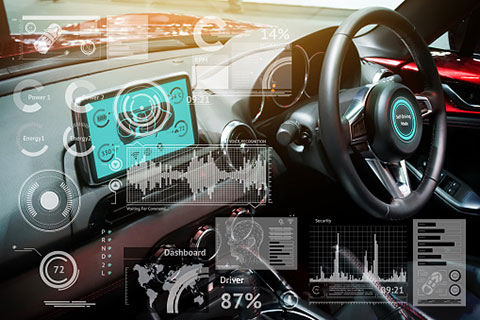Have you ever been cruising down the highway when your favorite song came on? How did you react?
Most likely, the volume spiked, along with your speed. The scenery whipped by as you rocked out, and for those few blissful minutes, every adverse aspect of driving was evaporated.
Theres a reason for this nearly universal experience: Music taps into the deepest parts of our brains, and works to not only elevate our mood but decrease our sense of effort, distracting us from feeling fatigued, and increasing our endurance in the process.
In other words, those frequencies make us more efficient. And now, the same can be said for our vehicles.
The same network used to deliver our songs will let our cars host their own talk shows in the future, allowing our vehicles to listen in—and communicate with—each other in real time as they navigate through an increasingly animated world.
So important is the ability for our autos to access the airwaves that the Federal Communications Commission (FCC) just opened up an additional 5 gigahertz of radio space for them—quintupling the current volume of the spectrum dedicated to our vehicles.
The move is a huge boost for developing self-driving technology, reorganizing the priorities of an already overcrowded space to make room for the millions of new vehicles that will need to utilize it. If successful, it could help usher in the era of driverless cars at an even faster pace than predicted—and help us avoid a crash course on our way to adopting future forms of transportation.
Something in the Air
The electromagnetic spectrum is to self-driving cars as oxygen is to their human passengers: invisible, and indispensable.
By speaking with other autos, our cars can share their speed, location, and position on the road, allowing nearby vehicles to adjust accordingly.
Much like the air we need to create the sounds of speech, the waves are required for our machines to broadcast their thoughts. But unlike the regenerative gaseous substance, electromagnetic waves are fixed.
Theres only so much room in the spectrum, which is why the government delegates its use through the FCC. By opening up the additional space there for self-driving technology, the agency helped breathe new life into the industry, giving it much more leeway to operate and experiment.
Thats because access to the radio waves is crucial for the cars to communicate.
Autonomous vehicles rely on a number of factors to get around, but one of the most important sources of information they have is each other. By speaking with other autos, our cars can share their speed, location, and position on the road, allowing nearby vehicles to adjust accordingly.
The spectrum also helps the cars paint a more complete picture of their surroundings by supporting their suite of sensors, radar, and lasers, which allow self-driving models to perform essential functions like changing lanes, braking, and looking for blind spots.
Its all done through a system called dedicated short range communication, or DSRC, which gives the vehicles enough of a broadband boost to transmit in a range of about 300 square meters—enough to converse with other cars in the area without clogging the spectrum. Such conversations are called vehicle-to-vehicle or V2V communication.
The DSRC frequencies are broadcast in a similar way to WiFi, and, like the invisible Internet waves, rely on the electromagnetic spectrum to get around. In fact, the competition for the space created by increasing interest in WiFi was a large factor in the FCCs decision to open up more room for the self-driving technology.
Another was the potential safety boon the vehicles could offer.
If executed well, V2V communication could reduce crashes in even our current cars by up to 80%, according to the National Highway Traffic Safety Administration.
In the self-driving cars of the future, that number could be even higher.
But our vehicles arent the only objects waiting to speak up.
Broader Horizons
A rising tide lifts all boats, and a thinking road enlightens all cars.
A large factor in the continuing education of our vehicles is the advancement of the automotive ecosystem around them.
Smart cars wouldnt be nearly as clever without vehicle-to-infrastructure (V2I) capabilities: An open line of communication giving the autos a way to speak not just with one another but directly to their surrounding environment.
By connecting our cars to, among other objects, signs, lights, and the roads themselves, V2I will help fill in any blanks left by V2V, like current road and weather conditions, construction site locations, and changing speed limits. The widespread application of vehicle-to-infrastructure communication can also streamline a number of roadside activities, from traffic reduction to toll collection to truck inspections, according to the FCC.
And the technology has the chance to make our roads even safer, showing the potential to eliminate up to 2.3 million crashes annually, the Department of Transportation reported.
The shared knowledge makes for a much more informed conversation—and a much noisier world. To get in on the discussion, our infrastructure must also connect to broadband, and borrow more from the same overtaxed spectrum to broadcast their thoughts.
As such technology continues to develop and become more popular, will we find enough room on the airwaves for it—or have to radio for help? Stay tuned.
